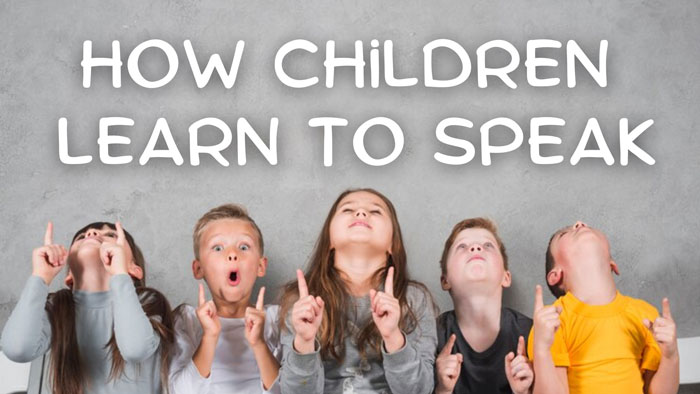How Children Learn to Speak
Introduction
Learning to speak is one of the most fascinating and complex processes in human development. Children don’t learn language the same way they learn to ride a bike or do basic math. There are no formal lessons, no instruction manuals.
Language simply emerges, step by step, through interaction with the world around them. In this article, we’ll explore the main stages of language development in children, from their first sounds to fluent communication, with a particular focus on European Portuguese.

Before Words: The Sounds of the World
The process of learning language begins long before the first word. From birth – or even earlier – babies are absorbing the sounds around them. Studies show that newborns recognize their mother’s voice and distinguish the rhythm of their native language. In the first few months, they begin to produce vowel-like sounds (such as “aaa” or “uuu”) and, around 4 to 6 months, enter the babbling stage, producing sequences like “bababa” or “dadada”. These sounds don’t yet have meaning, but they represent essential training for the muscles involved in speech.
The First Word: A Milestone Moment
Most children say their first word around 12 months old. This might be “mama”, “papa”, or something related to everyday objects or routines, such as “water” or “ball”. At this stage, each word is often used to express a complete idea. For example, “milk” may mean “I want milk” or “I see milk”. This phenomenon is called a holophrase and is characteristic of the initial stage of language development.
Vocabulary Explosion: Naming Everything
From around 18 months, many children enter a phase known as the “vocabulary explosion”. They begin learning new words at an astonishing rate – sometimes more than ten per day. This stage is marked by a great curiosity and eagerness to name everything in their surroundings. The first combinations of words also start to appear, such as “want milk”.
First Sentences: Language Takes Shape
Between ages 2 and 3, children start forming more complete sentences. The first verbs, pronouns, and articles appear, although errors are still frequent. A child might say “I doed” instead of “I did,” or “he have a big car” with still-childlike intonation. These mistakes are a natural part of learning. Children are applying grammatical rules creatively and intuitively, even if not always correctly.
Grammatical Development: From Simplicity to Complexity
Between ages 3 and 5, there’s a noticeable leap in linguistic complexity. Sentences become more structured, verb tenses are used with greater accuracy, and the child begins to master syntax. They also start asking more complex questions (“why is…?”), using conjunctions like “but”, “so”, or “because”, and understanding subtleties in speech.
Communication as a Social Tool
As development progresses, language becomes more than just a way to express basic needs – it evolves into a powerful tool for social interaction. Children learn to tell stories, play with words (like in rhymes or word games), and adjust their speech according to context (for example, speaking differently to an adult or to a classmate).
The Role of the Linguistic Environment
Although humans have an innate capacity for language, the environment plays a crucial role. Children exposed to rich, varied, and affectionate language tend to develop stronger linguistic skills. In the case of European Portuguese, it’s important to consider the specific phonetic and grammatical features that distinguish it from other Portuguese variants, which may influence how certain sounds or structures are acquired.
Errors, Repetition, and Learning
Making mistakes is part of the journey. Children go through phases where they say “doed” instead of “did” or “thwee” instead of “three”. Often, these “errors” are actually signs that they’re trying to apply general rules of the language. Constant correction isn’t necessary; what matters most is continuing to speak clearly and providing good language models.
Bilingualism and Simultaneous Learning
A common question is how children handle two languages from an early age. The good news is that the infant brain is incredibly flexible. Children exposed to two languages in natural contexts learn both proficiently, although they may mix vocabulary at first. In the context of European Portuguese, bilingual children might take a bit longer to separate structures and vocabulary, but they adapt naturally over time.
Technology and Language: Help or Distraction?
Nowadays, it’s impossible to ignore the role of technology. Educational apps, cartoons, videos, and interactive games are everywhere. When used appropriately, these resources can enrich vocabulary and spark interest in language. However, human interaction remains essential: it’s through direct contact, conversation, and attentive listening that children truly learn to communicate.
Different Rhythms, Different Styles
Not all children follow the exact same path. Some speak earlier, others later; some love to talk, others are more observant.
What matters most is respecting each child’s pace, providing stimulation and support without pressure. Language reflects individuality and, as such, follows diverse learning paths.
Conclusion
Learning to speak is an incredibly dynamic process, blending biology, social interaction, and natural curiosity. In the case of European Portuguese, children face specific challenges, such as articulating certain sounds or mastering complex verb forms – but they do so with remarkable competence. By better understanding these stages, we can not only support their development but also marvel at how human language is built from the very beginning.
Leave a Reply